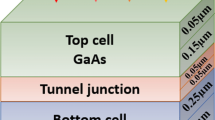Abstract
GaInP/GaAs dual-junction solar cell with a conversion efficiency of 25.2% has been fabricated using metalorganic chemical vapor deposition (MOCVD) technique. Quantum efficiencies of the solar cell were measured within a temperature range from 25 to 160°C. The results indicate that the quantum efficiencies of the subcells increase slightly with the increasing temperature. And red-shift phenomena of absorption limit for all subcells are observed by increasing the cell’s work temperature, which are consistent with the viewpoint of energy gap narrowing effect. The short-circuit current density temperature coefficients dJ sc/dT of GaInP subcell and GaAs subcell are determined to be 8.9 and 7.4 μA/cm2/°C from the quantum efficiency data, respectively. And the open-circuit cell voltage temperature coefficients dV oc/dT calculated based on a theoretical equation are −2.4 mV/°C and −2.1 mV/°C for GaInP subcell and GaAs subcell.
Similar content being viewed by others
References
Friedman D J, Kurtz S R, Bertness K A, et al. Accelerated publication −30.2-percent efficient GaInP/GaAs monolithic 2-terminal tandem concentrator cell. Prog Photovoltaics, 1995, 3(1): 47–50
Yamaguchi M. III–V compound multi-junction solar cells: present and future. Sol Energy Mater Sol Cells, 2003, 75(1–2): 261–269
Dimroth F, Beckert R, Meusel M, et al. Metamorphic GayIn1−y P/Ga1−x InxAs tandem solar cells for space and for terrestrial concentrator applications at C > 1000 suns. Prog Photovoltaics, 2001, 9(3): 165–178
Wysocki J J, Rappaport P. Effect of temperature on photovoltaic solar energy conversion. J Appl Phys, 1960, 31(3): 571–578
Fan C C J. Theoretical temperature dependence of solar cell parameters. Sol Cells, 1986, 17(2–3): 309–315
Friedman D J. Modelling of tandem cell temperature coefficients. IEEE 25th PV Spec Conf. 13–17, May, 1996, 89–92
Ai B, Sheng H, Ban Q, et al. QE and Suns-Voc study on the epitaxial CSiTF solar cells. Sci China Ser E-Tech Sci, 2005, 48(1): 41–52
Green M A, Emery K, King D L, et al. Solar cell efficiency tables. Prog Photovoltaics, 2007, 15(1): 35–40
Feteha M Y, Eldallal G M. The effects of temperature and light concentration on the GaInP/GaAs multijunction solar cell’s performance. Renewable Energy, 2003, 28(7): 1097–1104
Levinshtein M, Rumyantsev S. Handbook Series on Semiconductor Parameters. Singapore: World Scientific, 1996. 33–102
Author information
Authors and Affiliations
Corresponding author
Rights and permissions
About this article
Cite this article
Liu, L., Chen, N., Bai, Y. et al. Quantum efficiency and temperature coefficients of GaInP/GaAs dual-junction solar cell. Sci. China Ser. E-Technol. Sci. 52, 1176–1180 (2009). https://doi.org/10.1007/s11431-008-0203-9
Received:
Accepted:
Published:
Issue Date:
DOI: https://doi.org/10.1007/s11431-008-0203-9




